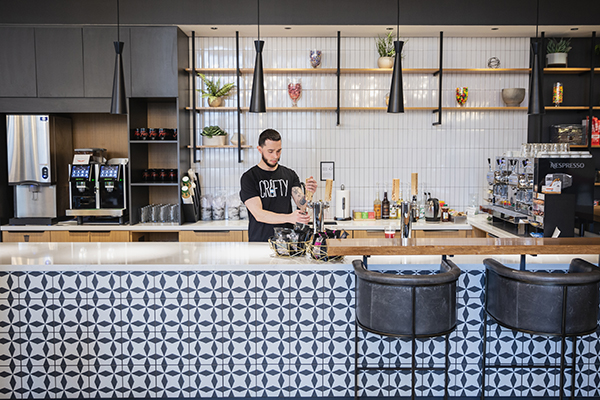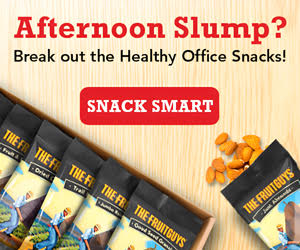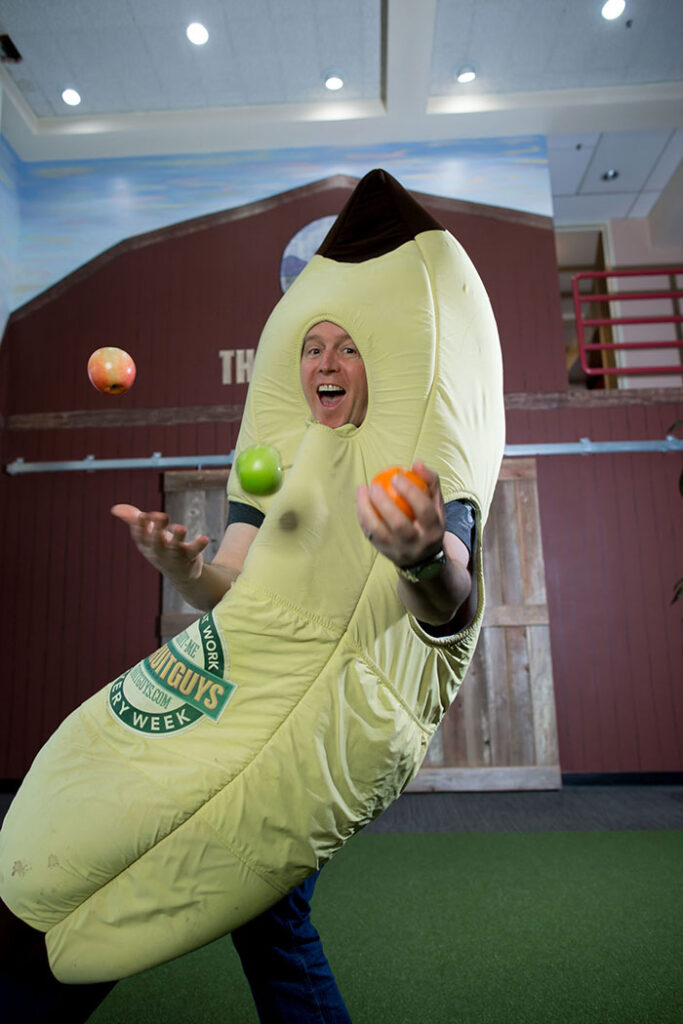How to Build an Office Snack Program on a Budget (5 Easy Steps)
- By Lex Flamm
- Reading Time: 7 mins.
Have you heard of The Perk Paradox? In the age of return-to-office efforts, it’s sneaking into almost every workplace and HR department like a kid on the hunt for a cookie jar.
The Perk Paradox is another name for the give-and-take relationship between offering workplace perks (like a healthy and delicious office snack program) and sticking to a tight budget. You have to navigate it to find that sweet spot where your employees and your Excel spreadsheets are both happy and healthy.

Beating the Perk Paradox
Beating The Perk Paradox can feel daunting, but it’s doable—whether you want to build a national office snack program or stock up a single break room. To help you get started, we spoke to the team at Crafty, the national office pantry provider whose CEO, Nate Rosenstock, coined the term The Perk Paradox in the first place.
Crafty specializes in providing high-quality, tech-enabled break room services to workplaces across the country. The Crafty Platform helps offices set and maintain their budgets and keep up with their orders, while Crafty delivers everything from coffee to The FruitGuys’ fresh fruit. The platform also crunches the numbers on what employees eat, helping office managers make smart decisions about pantry spending.
Here are a few steps Crafty’s team recommends taking to build an office snack program on a budget.
Step 1: Imagine Your Ideal Employee Experience
To beat The Perk Paradox, Crafty CEO and Co-founder Nate Rosenstock recommends a “bottom-up” approach. Instead of starting with your budget, he told The FruitGuys, start with how you want your perks to impact your employees.
“I always recommend starting with the employee experience first,” Rosenstock said. “Think about what you want each person to enjoy in a day—a granola bar, a piece of fruit, a cup of coffee, maybe a sparkling water—and build your budget from there.”
Here are a few stats to help you build out your experience.
- Snacks Per Day – Adults aged 20 and up typically have 1–4 snacks per day, according to a 2022 analysis.
- Coffees Per Day – 77 percent of coffee-loving workers “need two or more cups of coffee to feel productive,” according to a 2023 study. (Note: A beverage company paid for the study, so it may be a little biased.)
- Fruits Per Week – Clients of The FruitGuys typically snack on at least two pieces of fruit per person per week.

If you already have a snack program in place, pay attention to what your team is eating and try putting yourself in their shoes. Think about their workflows and the natural breaks in their workday. If you were a receptionist or a web developer, when would you get up to grab a snack? What would you go hunting for to boost your energy and sharpen your mind? (Check out these healthy office snack ideas for inspiration.)
“That bottom-up approach helps you land on a realistic per-person, per-day spend that actually reflects what your team will use and enjoy. Too often, companies start with a top-down number from finance that isn’t tied to real consumption. This flips that and makes the budget more intentional,” Rosenstock said.
Step 2: Calculate The Cost of That Experience
Once you figure out your ideal employee experience, it’s time to crunch the numbers on how much it will cost per month. You can ask a pantry provider like Crafty or use an AI assistant like ChatGPT to estimate what your ideal experience will cost for each employee.
Now, it’s time to see if that matches up with your monthly budget. Think about the size of your team and the number of workdays you’re providing snacks. Are you in the office all the time? Hybrid? Sending snack boxes or coffee pods to remote workers? Once you’ve figured out those numbers, plug them into Crafty’s formula to calculate your monthly budget.
Cost/Person/Day x Headcount x Working Days/Month = Monthly Budget

From there, Crafty recommends breaking that monthly number down further into per-delivery spend to make budget tracking easy.
Budget ÷ Deliveries/Month = Delivery Budget
If you’re starting your office snack program from scratch, you’ll also need to factor in a one-time startup cost for break room equipment. Items like coffee makers, water dispensers, office fruit and snack displays, and refrigerators are must-haves for a robust snack program.
If the monthly or delivery spend you arrive at is over your target, don’t panic! Take a deep breath and move on to Step 3.
Step 3: Identify Places to Save
There are a lot of ways to adjust your snack plan to make sure you beat The Perk Paradox. Here are a few tactics that will help you bring your ideal experience in line with your budget.
- Optimize Your Equipment – Invest in equipment that helps you save on costly single-packaged items. If your team loves cold brew, invest in a keg. If your team prefers black coffee over fancy espresso, ditch the bean-to-cup machine. If you’re spending a lot on sparkling water, consider a Bevi water dispenser.
- Weigh Quality vs. Quantity – What matters most to you: that your team has an abundance of options to graze on, or that their snacks have a real “wow” factor? If quantity is your focus, swap in lower-priced items without reducing the snacks per person. (Apples and bananas, for example, have a lower price point than tropical fruits.) If quality matters more to you than quantity, reduce the number of snacks you offer but focus on truly premium ones.
- Focus on Favorites – Pay attention to what your team is snacking on or send out a survey to see which snacks and drinks they’re excited about. Then, use what you learn to bring your ideal experience in line with your budget.
- Merchandise Wisely – The way you display your snacks can impact your budget. If your baskets are massive, then you’ll be forced to buy more just to fill them, so make sure you right-size your displays for your team.

If you’re still over budget after using these tactics, remember that you can always optimize as you go (more on that later). Now, on to the fun part: shopping!
Step 4: Choose Your Products
Variety is the spice of life, so Crafty recommends bringing as much of it into your office snack program as you can within these four categories: snacks, drinks, coffee, and perishables (like fresh vegetables, fruits, yogurt, and deli meats). The more room you have in your budget, the more options you can bring in per category.
You can choose each item individually or take a category shortcut with a product like The FruitGuys’ Thoughtful Snack Box, which comes with a rotating assortment of clean-ingredient snacks at a fixed per-box cost.
Step 5: Launch Your Office Snack Program, Optimizing as You Go
Once you implement your program, it might be tempting to kick back, relax, and let it run. But according to Crafty, this is when the real learning starts.
After you launch your program, keep an eye on how your team reacts. Check what’s left in the break room or snack station each day, pay attention to which snacks disappear first and which ones linger, and add a suggestion box where the team can share their feedback.

Tech tools can help you with this analysis so that you don’t need to rely on hand-counting or reaching out to each of your company’s offices for data and consumption patterns.
Crafty Strategic Account Director Hector Avelar told The FruitGuys that with Crafty’s inventory management platform, HR and office managers “can easily hop in to see exactly what was ordered, how that tracks against the budget, and see how it’s performing with employees over time.”
He added, “I can pinpoint spend spikes and connect them to what’s happening onsite. It gives clients real transparency into consumption, without all the manual work.”
How to Adjust Your Office Snack Program to Fit Your Budget
Once you’ve crunched the numbers, it’s time to start optimizing your office snack program. Here are a few tweaks Crafty recommends.
- Cut Unloved Products — Does your team always go for meat sticks and granola bars, while trendy drinks linger in the fridge? Remove a few drink options to cut costs, or shift the money you were spending on drinks to another category and add more variety there.
- Swap In Affordable Versions — Try switching to a lower-priced snack or coffee option and see if it impacts your team’s choices.
- Test New Items — If a particular flavor of coffee creamer is moving slowly, swap it out for a different one to see if you get better results.
- Switch Up Your Merchandising — Reorganize your kitchen or snack station and track its impact on your team’s eating habits.
You might be surprised how easy it is to nudge employees in the right direction with merchandising.
“Most people are right-handed and make fast, visual decisions, so they tend to reach for whatever’s at eye level and on the right side. That’s why merchandising matters so much. If you put healthier or lower-cost items where they’re easiest to grab, you can influence better choices and manage spending without saying a word. Small layout changes can have a big impact on how people engage with the space and therefore how much you spend,” Avelar said.
By following these five steps, you can stay on budget and keep your team happy and healthy—protecting your cookie jar from The Perk Paradox kid.


